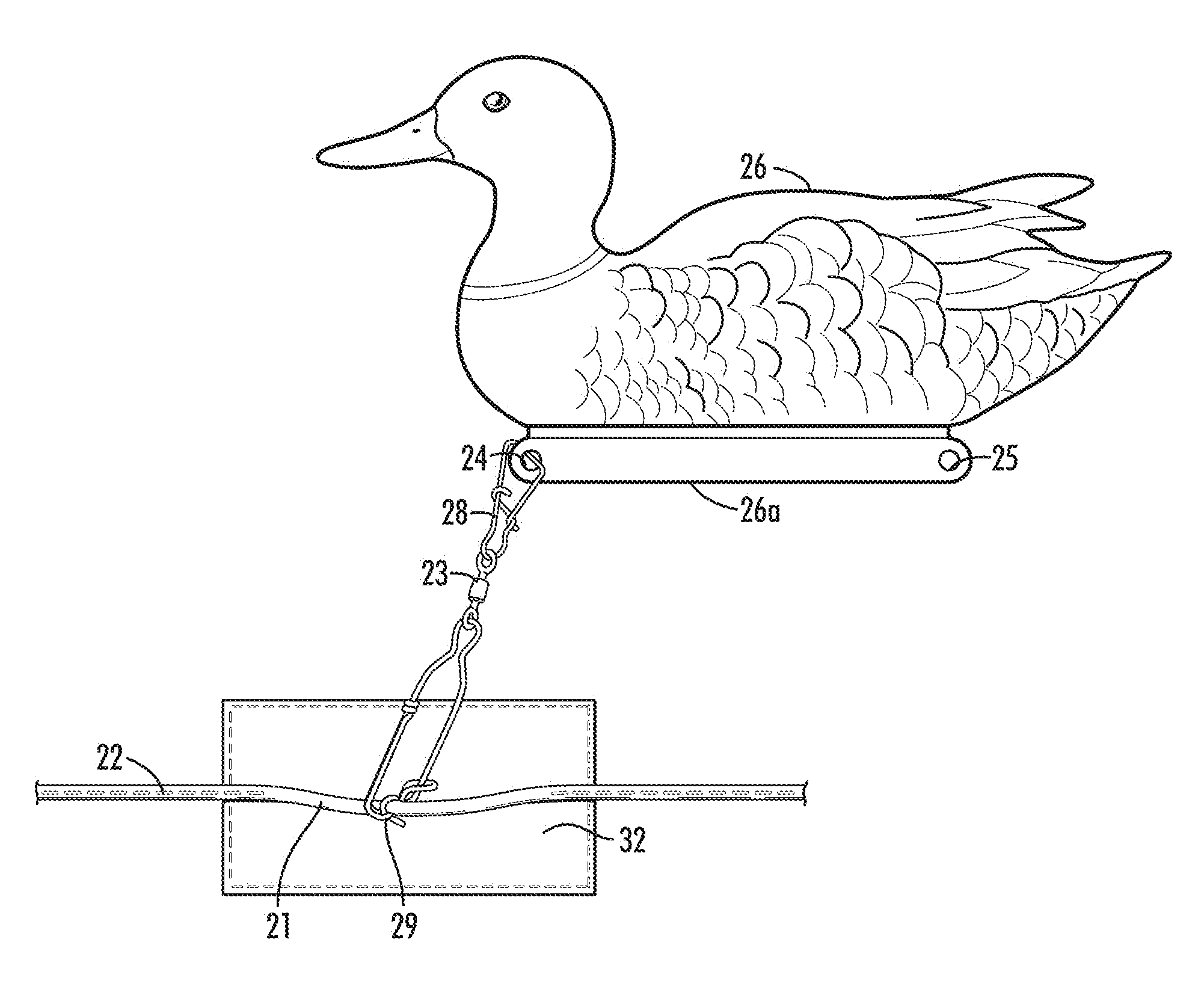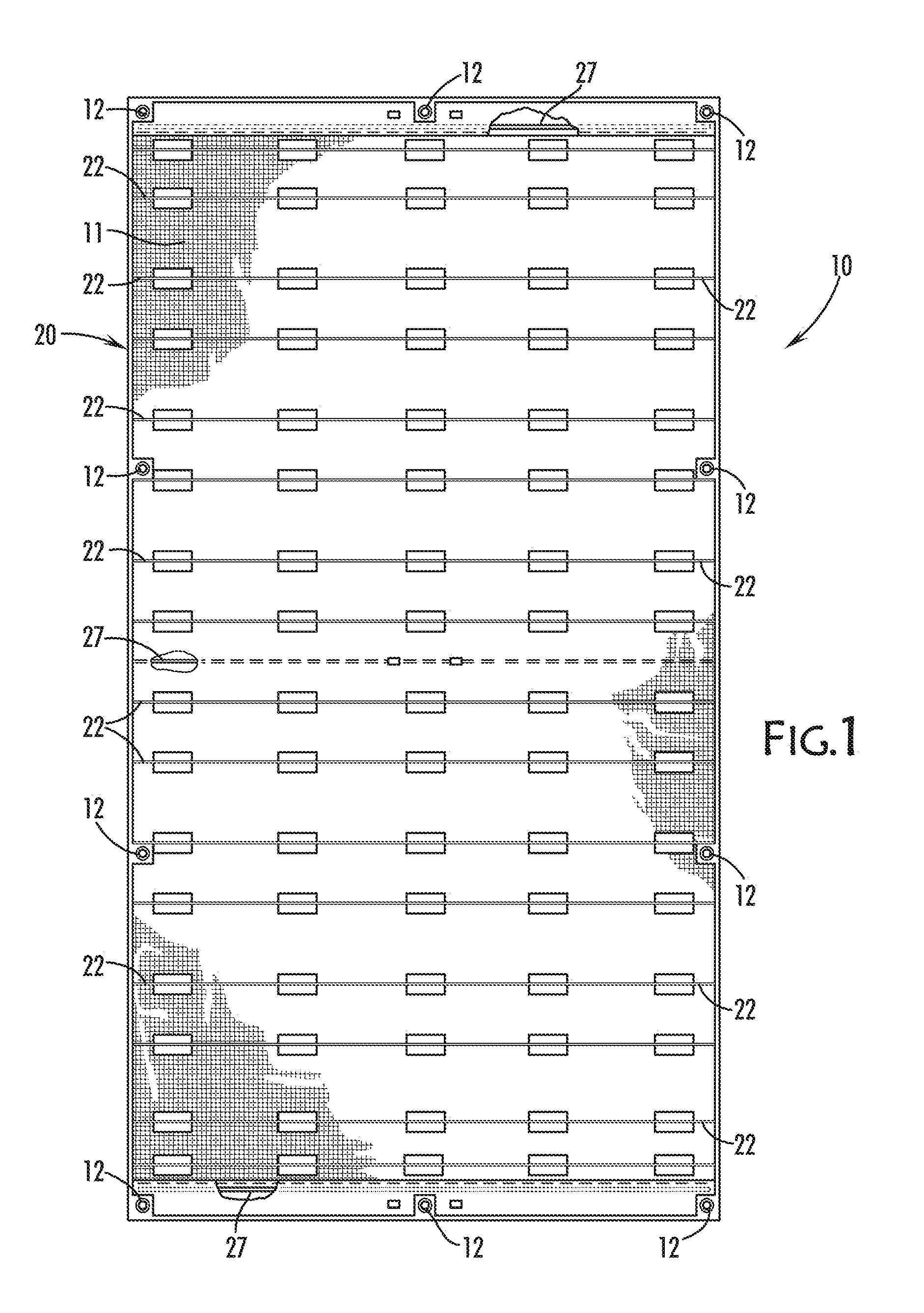When these individually thrown (deployed) decoys land in the water, if they should land too close to each other, they can frequently tangle because of the long cords, water currents, and wind.
As a result, it is difficult for users to achieve the desired look of rafting ducks using the individual duck decoy displays.
There are problems with this method.
It is difficult to display the decoys in a tight configuration without tangles developing in the line and among the decoys.
The longline rig is a useful way of deploying a lot of decoys quickly, but it does not achieve the tight rafting of ducks, as the decoys are typically four or more feet apart, and in a direct line.
Because the decoy is attached on both ends of the
keel, the decoy is not able to move and adjust to the water current as freely as one that is attached on just one end of the
keel.
As a result, the conventional makeshift / homemade net rig takes considerable effort to deploy, to achieve the desired look of rafting ducks.
Further, performing such a deployment in the early
morning darkness can prove challenging, especially in challenging conditions such as, for example, high wind, strong current, rain etc.
A major problem for users of conventional makeshift net rigs is the occurrence of tangles.
Because the user of a net rig is typically required to anchor the net rig with four or more suitable anchors, even a directional shift in the water current can cause the net rig to tangle.
Deploying the net rig in deeper water also proves problematic for the user because of the amount of time it takes for the anchors to reach the bottom of the water.
The
delay in the anchors falling to the bottom causes slackness in the net rig.
This causes the decoys to eventually begin bumping into one another, and the decoys in the net rig are no longer providing a true appearance of actual waterfowl.
Additionally, users that hunt waterfowl in areas that are affected by tidal changes often must expend considerable effort to re-set the net rig as the water currents and tide shifts occur.
This consumes additional time for a user, as the user must forego hunting until the net rig can be readjusted.
In addition, because the decoys are attached to the net at both ends of the decoy
keel, they are unable to adjust to changing wind, water currents, and directions.
The large openings are problematic because the decoy can become stuck in various configurations when the decoy bills, or zip ties become caught in the netting.
This can also require the user to expend additional time and labor fixing individual decoys prior to or during deployment, as well as having to tediously repair snags in the net.
These issues can prove to be difficult, especially during cold, windy, and wet weather.
When a duck has been shot, it can fall into the water, often near or within the duck decoy “spread.” The problem with the conventional makeshift net rig is that the dog risks being caught in the larger mesh openings of the nylon or monofilament
fishing net if the duck falls near or into the net rig.
This can prove fatal to the dog.
Many hunters refuse to use, or are unable to use a makeshift net rig because of this danger alone.
While each of the above described devices and methods may be suitable on occasion for the particular condition to which they address, they are not suitable for reducing or eliminating the various problems and issues associated with their decoy use.
Hunting for waterfowl in
open water can be a challenge to the decoy user, for many reasons.
One of the major challenges is simply the fact that the user is often required to display a large number of decoys to attract attention from the passing waterfowl.
Multiple decoys can occupy a significant amount of square footage, and are cumbersome for the user to
handle, store, transport, deploy, and remove from the water.
Working to display dozens of decoys on the
open water is both grueling and
time consuming, especially in colder temperatures.
Use of one's hands numbed by the
cold weather can be difficult and painful.
Strong water currents and high wind can make for good duck hunting conditions, but they can also create difficult conditions for deploying a conventional makeshift net rig and preventing entanglements.
When an entanglement occurs, the user is required to make extensive use of their hands, wrists and fingers, which are often wet and numb when the weather is cold.
Whether the user deploys a single decoy setup, longline rig, jerk rig, or makeshift net rig, net and decoy entanglement is inevitable and undesired, as explained above.
The bills and tails of the decoys can easily become wrapped up and tangled in any type of rigging currently being used by hunters.
These methods increase the time required to deploy the decoys, the time to untangle them, and the time to remove them from the water.
The conventional makeshift net rig's propensity for entanglement also makes it difficult to store because the decoys cannot be easily removed.
As a result, decoys tend to bump into each other and are prone to paint chipping and discoloration.
Thus, the decoys on a conventional makeshift net rig generally do not receive the same care as those used on an individual decoy rig.
 Login to View More
Login to View More  Login to View More
Login to View More 


